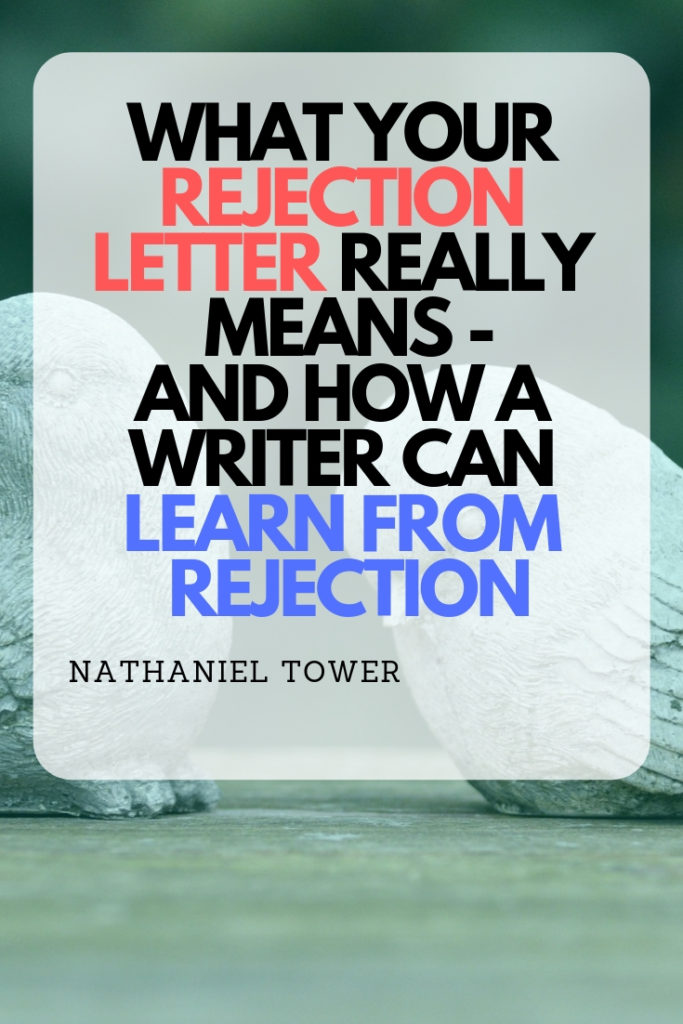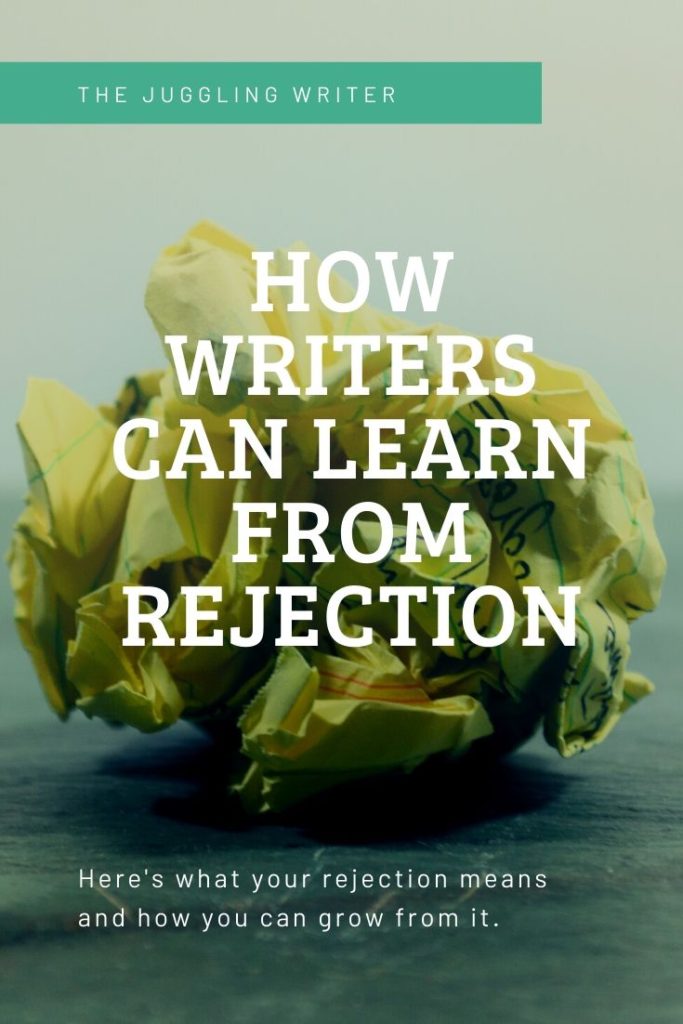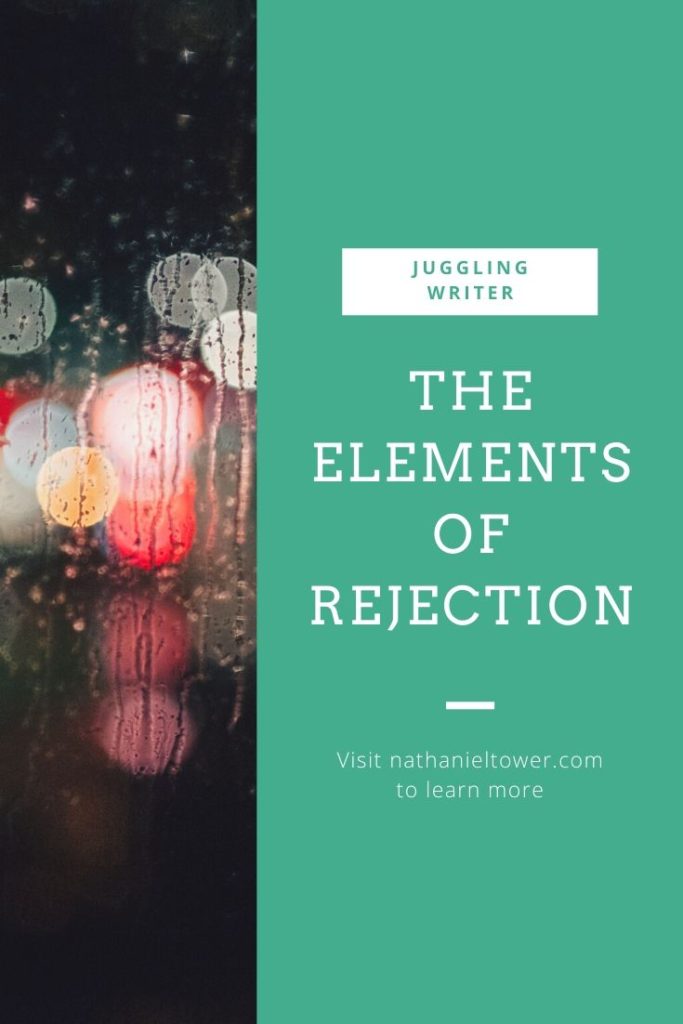Last Updated on July 8, 2023 by Nathaniel Tower
Writers are probably the most rejected people in the world. You’d think after all that rejection you’d be able to take a hint. Yet many writers don’t seem to be able to read between the lines when it comes to the contents of their rejection letter.

Here’s a quick anecdote regarding a writer who has become a frequent submitter over at my lit mag Bartleby Snopes. First, some background. We always provide feedback on submissions (unless a writer opts out), but every response starts from a basic template. Our standard template ends with a response that goes a little something like this:
Good luck with this one elsewhere. Feel free to try us again in the future with something new, but please wait at least one month before submitting again.
If you’ve submitted to more than a handful of places, then you’ve probably seen something like this before. Even if you are getting a “personal” rejection, chances are that part of the response is a default message.
So here’s the story: A writer whose story we rejected submitted again the next day. We gave him the benefit of the doubt and considered the submission anyway. Within a few days of the next rejection, he sent another submission. And then another. At one point, he had three separate submissions live in our queue. We typically respond to submissions within 3-5 days, and we weren’t going to let this writer mess up our stats. So we responded to his submissions (all rejections). Almost immediately, there was another story from him in the queue. It was his tenth submission within a month. This time I delivered the message loud and clear: You need to wait at least 30 days before submitting again. Anything you send before that time will be returned unread.
He almost got the message. The next submission came 15 days later. We rejected it as soon as we saw it, but this time we tried a different approach. We simply changed the status to “Declined” without actually sending a rejection email. It may seem cruel, but we were at wit’s end. He hasn’t submitted again (yet).
Here’s the bottom line: this writer just didn’t get it. While his circumstance may be extreme, plenty of writers don’t get what the rejection message is really saying. I’ve certainly been guilty of this in the past.
In order to figure out what a rejection really means, let’s break it down into four parts:
- The Greeting
- The Introduction/Lead
- The Feedback/Rejection
- The Closing/Invitation
The Greeting
The rejection greeting is simply how the venue greets you in the letter. There are three basic types of greetings:
- Personalized (such as “Dear [Name]”)
- Generic (such as “Dear Writer”)
- Blank (as in the letter doesn’t greet you at all)
If your rejection falls under greeting options 2 or 3, then you can safely assume that this publication does not really care to see more work from you. You did not make enough of an impression to even warrant the recognition of your name.
The vast majority of rejections I have received have started with some variation of #1. Before we get too excited here, this does not necessarily mean that we were close to an acceptance or that the publication wants to see more work from us. Most of the time, this “name” is auto-generated. Still, having your name on there is a sign that you are headed in the right direction. Or, more accurately, it’s the best possible greeting you can get.
The Introduction/Lead
After the greeting, you will probably have some type of introduction. I like to call this the lead because ultimately it is a statement leading to your rejection. This is almost always in the form of:
Thank you for submitting [Title] to us…
This lead may be followed by a we appreciate the chance to read your work, or some other generic message of that nature. Although generic, this is a good start (but, once again, not necessarily a sign that you are close to an acceptance).
Another common type of lead is the one of condescension. It goes something like this:
We receive thousands of submissions every minute and cannot possibly accept all of them…
This type of lead is not a good sign. It’s similar to the lack of name recognition. It is a confession from the publication: they are great and you are mediocre. You aren’t really worth their time, especially compared to everything else they get.
There is a third type of lead you might get in your rejection, and it’s the least pretty of them all. It goes like this:
Sorry…
Yes, that’s right. It almost doesn’t exist at all. Instead of leading into the rejection, they just get it all over with. It’s the ultimate breakup. If your rejection letter starts like this, you would be well-advised not to submit another piece to this publication.
The Feedback/Rejection
Here is the meat of the rejection letter, the part we’re all looking for when we get that response from a publication. This is where we find out the ultimate fate of our story, poem, novel, collection, etc.
More often than not, the rejection will not be personal. It will go something like this:
After careful consideration, we have decided to pass on this piece.
OR
This piece is not for us.
In truth, there is no difference between these two lines of rejection. Both have the same message: we aren’t taking your piece, and that’s all there is to it. You shouldn’t try to interpret this. It’s a form letter. Different publications have different styles of rejection, and some may seem more friendly than others. Just accept that your piece was rejected and move on to the end of the letter.
However, if you received personalized feedback, then there is some room for interpretation. The possibilities for personal feedback are practically limitless, but there are two basic categories in which all personal feedback falls:
- Feedback about the writing (style, prose)
- Feedback about the content (plot, characters)
Each category also has two basic subcategories: subjective or objective.
Feedback about the writing will relate directly to how the piece was written. Objective feedback includes poorly crafted sentences, typos, structural issues. Subjective feedback relates to things like “the writing didn’t have enough punch” or “it was overly descriptive for our tastes.” Feedback related to the writing usually indicates that your submission is pretty far off. Maybe they like the storyline but not your delivery. In other words, the problem is you.
Feedback about the content is more an opinion on the idea rather than commentary on you as a writer. This feedback might tell you the story felt cliché, that the characters weren’t developed, that the ending fell flat. These are things that might be easier to fix than the writing style. It’s not necessarily you as a writer that’s the problem, just this particular submission.
Of course, no feedback will provide you with the ultimate answer regarding what the rejection means (including if the rejection letter says “This one was really close for us…”). But the feedback can give you clues.
The Closing/Invitation
Depending on what comes before it, the closing/invitation is your biggest clue. There are three basic types of closings:
- Signing off with no invitation to submit again
- Signing off with a generic invitation to submit again
- Signing off with a sincere invitation to submit again
The first closing needs no explanation. If the publication doesn’t ask you to submit again, then don’t. Why waste your time?
The difference between #2 and #3 can sometimes be difficult to pinpoint. A generic invitation to submit again (like how we usually do it at Bartleby Snopes) will often sound something like this:
Feel free to try us again, but wait at least X days/weeks/months…
If it sounds like something they probably say to everyone, then it probably is. There’s nothing here that compels you to submit again (although many writers respond thanking us for the opportunity to do so). Of course, you shouldn’t take this to mean they don’t want you to submit again. They very well may want you to send something else (at Bartleby Snopes, we will actually remove this line if we really don’t want the writer to submit again). However, don’t jump for joy because of a generic message.
To determine whether or not you have a sincere invitation to submit again, look for language that sounds sincere. Yeah, it’s not rocket science. If the rejection says “We really enjoyed the submission but don’t think it’s quite right. We do hope you will submit again,” then you can probably safely assume they actually want to hear from you again. Another way to determine if it’s a legitimate request to submit again: send them something else and wait for the response. If you get another rejection letter that looks exactly the same, then you can assume it’s probably what they say to everyone.
The Takeaway
Ultimately, a rejection letter can tell you a lot, but it also won’t guarantee any future publications. The best approach to a rejection letter is to look for any valuable feedback and take it into consideration when revisiting your rejected piece. A rejection letter can also be a great way to gauge whether or not a publication is a good fit for you. If the rejection letter leaves a sour taste in your mouth, then you can scratch that publication off your list. Don’t submit somewhere if you don’t like how they make you feel.
Of course, in some cases, you won’t receive a rejection letter at all. This is what we call the silent rejection, and it’s possibly the most miserable type of rejection.
What do you take from a rejection letter? Share your rejection stories and rejection advice in the comments.



Reblogged this on White Shadow, LLC.
I have to confess that I don’t understand the reasoning behind limiting submissions to no more frequently than once a month (or whatever term). If it’s truly the story you’re considering (rather than the writer), then why must there be a lag? What is achieved in 30 days?
If I wrote under four pen names (I don’t — one is enuf!) and submitted a different story to you each week under the alternating names, you likely wouldn’t know (okay, maybe you would based on style or subject matter or word choice) and the stories would be considered as stories rather than as more annoying submissions from “that writer.” Yet how would the inherent worthiness of these four stories be different from the same submitted with the same name? If you approached each story as independent of the others (because of the pen names) you would likely give it careful and professional consideration. Why is it different if each had the same author name?
I’ve seen some submission requirements that call for stripping out the author’s name from the document. (I suppose that is so that my submission can get equal initial consideration as one by a fellow named Franzen.) When this is the case, how would the editors know if I sent in one piece or a dozen? And why would it matter if it is the story that they are considering?
I don’t know that I oppose the once-a-month limitation, but I don’t understand the reasoning for it.
Paul, thank you for reading and commenting. You make some great points here. Submission requirements do vary a lot, and I believe every publication has its reasons for doing things a certain way.
For us, the 30-day waiting period is to make sure we can respond to all submissions in a timely fashion. We strive to respond to all submissions with personal feedback in 3 to 5 days. If the same submitters decide to send work over and over, we won’t be able to keep up. Really, it’s our way of keeping it fair to everyone. Sure, you could have four pen names, but that is more difficult these days with Submittable. You’d need four different accounts. That would be a lot more trouble than it is worth!
We do sometimes waive the waiting period if a submission is really close. Also, I think the waiting period benefits the writer. It gives the writer a chance to digest any feedback and look over the publication more. It keeps us from dashing off another submission that might not be a good fit. I know I have been guilty of doing that, and it never has resulted in an acceptance.
I am a new and unpublished writer who only started submitting this year, so perhaps you can clarify a situation I have encountered. My first piece was rejected with personal comments, my second with an encouraging note from the editor mentioning my piece was in the top 5% and offering detailed critique (which I warmly accepted), but then the next two submissions were rejected with only the most generic form letters. Should I assume my first pieces were a fluke and I lucked into getting strongly considered, or go with the advice that if I receiving form letters they probably don’t want more? The mixed signals are ambiguous, as I can’t decipher any percievable difference of quality between my favorably received submissions and my form letter rejections. I don’t want to waste my time, but I also don’t want to give up prematurely.
Are these all from the same venue? If they were sending you personal letters at first and then started sending form letters, I would generally say it’s time to move onto other venues. Or at least take a break from that venue for awhile.
Hi Nathaniel,
I am just starting out so I was anticipating rejection letters out of the gate. I can sense the ones that are generic easily. I have a 3 poems and One CNF/memoir piece that I have been submitting. Is any bit of personalization considered a close one or does it have to be extremely specific? For example, I received one last night for my memoir piece that said “this was very well written and we appreciated having read it” and it closed with “we thank you for having submitted it and hope you will submit with us again”. And another venue called out one of the three poems that I had submitted as one whole submission. They said “Although we must decline your submission this time, we greatly appreciated the chance to read your work–it was truly our pleasure. “A Familiar Heartache” was very close.
Thank you, again. We wish you the best of luck in placing this elsewhere, and hope you will consider submitting to us again.”
Neither venue gave me any specific feedback or critique, so I can’t tell if this is just the extra soft straight rejection or should I consider it a little bit more than that and feel encouraged? I am just trying to get my barometer right and I feel these two responses didn’t match up neatly with any one specific example you had shared. Thank you for any and all input!
Hi Maggie! Thank you for reading and commenting, and congrats on the near-acceptance! It sounds like this was a form rejection letter with an encouraging personal touch that elevates it above the straight rejection. I would take them for their word and assume they really meant the piece was close to being accepted. It would be a lot easier for them just to reject you with no commentary, so the fact that they took the time to identify a particular poem and say it was close tells me that it was actually close. Depending on their submission guidelines, I would try them again with a similar piece and see if you can get an acceptance. Just give it a couple weeks at least before you send in something new.
Please come back here and leave a comment when you get your poems accepted!
Well as luck would have it, the short CNF/Memoir piece I also mentioned in my original post that had just recently received a form rejection letter with a little extra personalization that said “this was very well written and we appreciated having read it”, was just accepted today for publication!!! What timing!
While I feel very fortunate and realize there are many more rejection emails in my future, it was a nice confidence boost to get an acceptance email. It felt amazing! Thanks again for replying to my original comment and question. (-:
Congratulations! Please share it with us here when it gets published!